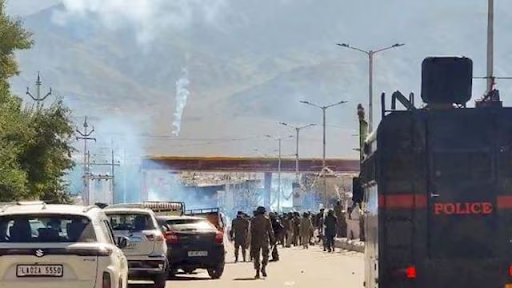



The Punjab-Haryana Bhakra water dispute escalates as BBMB orders extra release to Haryana, citing drinking water needs. Punjab opposes, citing low dam levels and prior over-withdrawal by Haryana. Environmental stress and pre-monsoon scarcity worsen tensions. Legal battles and expert intervention may determine a balanced, long-term, and sustainable resolution.

Copyright infringement not intended
Picture Courtesy: INDIAN EXPRESS
The Bhakra-Nangal project consists of two complementary dams on the River Satluj:
Prior to the reorganization of Punjab in 1966, the Bhakra-Nangal project was managed directly by the undivided Punjab government. Following the state's division into Punjab, Haryana, and Himachal Pradesh, the Bhakra Management Board was established under the Punjab Reorganisation Act to ensure equitable distribution of water resources.
In 1976, it was renamed the Bhakra Beas Management Board (BBMB) and provided additional responsibilities for managing projects on the River Beas, including the Beas-Satluj Link Project (Pandoh dam) and Pong dam in Himachal Pradesh.
Current Water Allocation Framework
The BBMB plays a pivotal role in water distribution between five states: Punjab, Haryana, Rajasthan, Himachal Pradesh, and Delhi. At the beginning of each accounting year (approximately September-August, depending on monsoon patterns), the BBMB determines water allocations for each state.
For the current accounting year, the allocations were established as follows:
Haryana formally requested 8,500 cusecs of additional water from the Bhakra-Nangal project, which would be 4,500 cusecs above its current allocation. Punjab Chief Minister rejected this request, deferring the decision to the BBMB.
The BBMB conducted a meeting—Haryana, Rajasthan, and Delhi—voted in favor of releasing extra water to Haryana, effectively overriding Punjab's objections. Himachal Pradesh abstained from voting.
Punjab refused to open an additional floodgate at the Nangal dam that would allow the extra water to flow to Haryana. In response, the Haryana government announced its intention to approach the Supreme Court to secure what it considers its fair allocation of water.
Punjab started exploring legal options to challenge what it terms an "unprecedented" decision by the BBMB. All political parties in Punjab—regardless of their alliances—unified in opposition to the BBMB's directive.
Punjab's Position
Haryana's Position
Environmental factors are exacerbating the current water crisis
Reduced Snowfall in the Himalayas: Diminished winter snowfall has contributed to lower water levels in the dams. This is consistent with broader climate change patterns affecting the Himalayan region.
Declining Reservoir Levels: All three major dams in the system are showing lower water levels compared to the previous year, suggesting a systemic water shortage rather than a localized issue.
Seasonal Timing: The dispute is occurring at a critical time before the monsoon season, when water reserves are at their lowest.
According to experts: "If Haryana's population needs drinking water, it should be provided, especially since Punjab does not need extra water at this time... The only condition is that each state's quota must remain unchanged. If extra water is given to Haryana now, Punjab should be compensated later."
The Supreme Court may need to provide a binding resolution if the states cannot reach an agreement.
An independent expert panel could assess the actual water availability and needs of both states to provide an evidence-based recommendation.
Both states could implement enhanced water conservation strategies to reduce demand pressures.
Long-term solutions might include additional water storage capacity and improved water distribution systems.
Must Read Articles:
Tamil Nadu-Karnataka Water Dispute: Pennaiyar River Case
Interstate river water disputes inter state
Source:
|
PRACTICE QUESTION Q. Critically analyze the role of the Central Government in adjudicating inter-state water disputes. 150 words |






© 2025 iasgyan. All right reserved